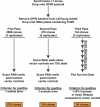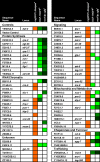Lifespan regulation by evolutionarily conserved genes essential for viability
- PMID: 17411345
- PMCID: PMC1847696
- DOI: 10.1371/journal.pgen.0030056
Lifespan regulation by evolutionarily conserved genes essential for viability
Abstract
Evolutionarily conserved mechanisms that control aging are predicted to have prereproductive functions in order to be subject to natural selection. Genes that are essential for growth and development are highly conserved in evolution, but their role in longevity has not previously been assessed. We screened 2,700 genes essential for Caenorhabditis elegans development and identified 64 genes that extend lifespan when inactivated postdevelopmentally. These candidate lifespan regulators are highly conserved from yeast to humans. Classification of the candidate lifespan regulators into functional groups identified the expected insulin and metabolic pathways but also revealed enrichment for translation, RNA, and chromatin factors. Many of these essential gene inactivations extend lifespan as much as the strongest known regulators of aging. Early gene inactivations of these essential genes caused growth arrest at larval stages, and some of these arrested animals live much longer than wild-type adults. daf-16 is required for the enhanced survival of arrested larvae, suggesting that the increased longevity is a physiological response to the essential gene inactivation. These results suggest that insulin-signaling pathways play a role in regulation of aging at any stage in life.
Conflict of interest statement
Competing interests. The authors have declared that no competing interests exist.
Figures


References
-
- Finch CE, Ruvkun G. The genetics of aging. Annu Rev Genomics Hum Genet. 2001;2:435–462. - PubMed
-
- Kenyon C, Chang J, Gensch E, Rudner A, Tabtiang R. A C. elegans mutant that lives twice as long as wild type. Nature. 1993;366:461–464. - PubMed
-
- Morris JZ, Tissenbaum HA, Ruvkun G. A phosphatidylinositol-3-OH kinase family member regulating longevity and diapause in Caenorhabditis elegans. Nature. 1996;382:536–539. - PubMed
-
- Kawano T, Kataoka N, Abe S, Ohtani M, Honda Y, et al. Lifespan extending activity of substances secreted by the nematode Caenorhabditis elegans that include the dauer-inducing pheromone. Biosci Biotechnol Biochem. 2005;69:2479–2481. - PubMed
Publication types
MeSH terms
Substances
Grants and funding
LinkOut - more resources
Full Text Sources
Other Literature Sources
Molecular Biology Databases
Miscellaneous

